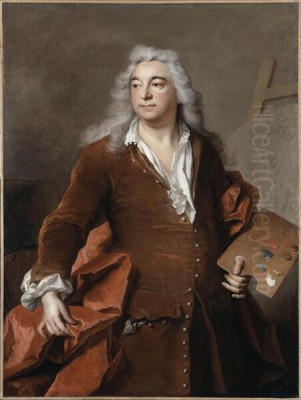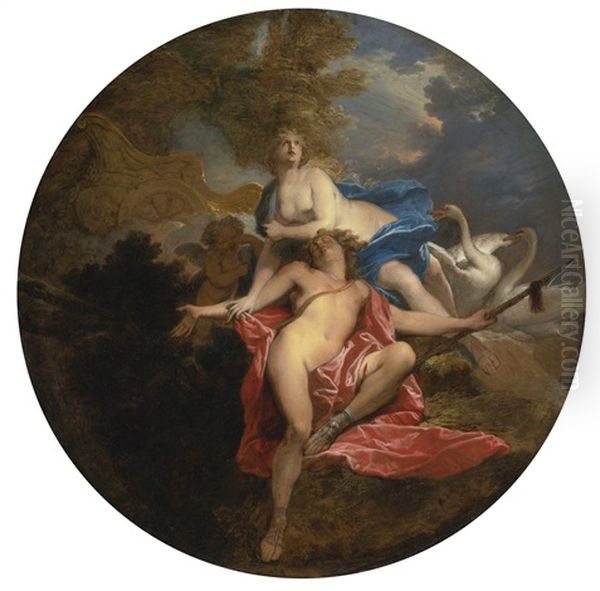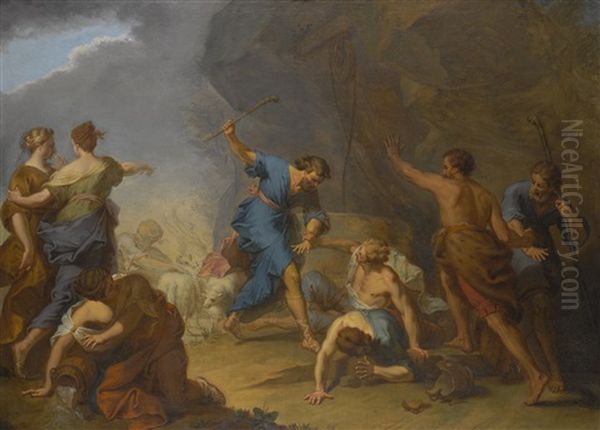
Nicolas Bertin (1668-1736) stands as a significant, if sometimes overlooked, figure in the vibrant tapestry of French art during the transition from the grandeur of the late Baroque to the burgeoning elegance of the Rococo. A prolific painter and occasional printmaker, Bertin navigated the shifting artistic currents of Paris, contributing a distinctive voice through his mythological and religious compositions. His career, marked by academic success and royal patronage, reflects the evolving tastes of an era moving towards greater intimacy and decorative charm in the arts.
Early Life and Artistic Formation
Born in Paris in 1668, Nicolas Bertin was immersed in a city that was the undisputed artistic capital of Europe. His formal artistic training began under the tutelage of Guy-Louis Vernansal, a painter whose influence, though less documented, likely provided Bertin with his initial grounding in the craft. More significantly, he subsequently became a student of Jean Jouvenet, one of the most prominent French religious painters of his generation. Jouvenet, a master of the Grand Manner, would have instilled in Bertin a strong sense of composition, dramatic narrative, and the academic traditions championed by the Académie Royale de Peinture et de Sculpture.
Further refining his skills, Bertin also studied with Bon Boullogne (Louis Boullogne the Younger) between 1684 and 1685. The Boullogne family was a dynasty of painters, and Bon Boullogne was known for his elegant figures and rich color, which would have complemented Jouvenet's more austere classicism. This period of intense study culminated in a major early achievement: in 1684, Bertin was formally associated with the prestigious Académie Royale, and in 1685, at the young age of seventeen, he won the coveted Prix de Rome. This prize, awarded for his painting The Construction of Noah's Ark, was a testament to his precocious talent and mastery of historical subject matter. The painting itself, a complex narrative scene, would have demonstrated his ability to handle multiple figures, dynamic composition, and a clear, legible story, all hallmarks of academic history painting.
The Roman Sojourn and Italian Influences

The Prix de Rome traditionally granted its recipient a period of study at the French Academy in Rome. It is highly probable that Bertin traveled to Italy around 1685, although precise dates can be elusive. Rome, with its unparalleled artistic heritage, was an essential finishing school for any ambitious European artist. There, Bertin would have been exposed firsthand to the masterpieces of antiquity and the Italian Renaissance. The works of Raphael, with their harmonious compositions and idealized figures, and the dynamic energy and rich colorism of the Carracci family (Annibale, Agostino, and Ludovico), founders of the Bolognese school, are cited as significant influences on his developing style.
This immersion in Italian art would have broadened Bertin's artistic vocabulary, allowing him to temper the French academic tradition with a greater sense of warmth, movement, and painterly richness. The experience in Italy was not solely about passive absorption; it was also a period of active engagement. Interestingly, during his time in Italy, Bertin is reported to have led a student protest against certain reforms in the teaching system of the French Academy in Rome, suggesting a strong-willed personality and a commitment to his artistic principles even at a relatively young age. This episode hints at a certain independence of spirit that would characterize his later career choices.
Academic Recognition and Mature Career
Upon his return to Paris, Bertin steadily built his reputation. His talent did not go unnoticed by the Académie Royale, the central institution governing the arts in France. In 1703, he was formally received (agréé) and then admitted as a full member (académicien) of the Académie Royale de Peinture et de Sculpture. This was a crucial step, conferring official status and opening doors to significant commissions. His reception piece, the specific work submitted to gain full membership, would have been carefully scrutinized by his peers and demonstrated his mastery of the prevailing academic standards.
Bertin's career flourished within the academic system. He became a respected figure, and in 1733, his contributions were further recognized when he was appointed "adjoint à professeur" (assistant professor) at the Académie. This teaching role indicates his standing among his colleagues and his commitment to perpetuating the artistic traditions he had mastered. Throughout these years, he was a regular participant in the Salons, the official art exhibitions organized by the Académie, which provided a vital platform for artists to showcase their work to patrons and the public. His paintings, often depicting scenes from Ovid's Metamorphoses or biblical narratives, found favor with a discerning clientele.
Artistic Style and Thematic Concerns

Nicolas Bertin is primarily recognized as an artist of the early Rococo, though his work often retains a certain classical structure and narrative clarity inherited from his Baroque training. His style is characterized by a delicate and refined touch, a preference for graceful, elongated figures, and a palette that, while capable of rich hues, often leaned towards the softer, more luminous tones associated with the emerging Rococo sensibility. He excelled in creating a dreamlike, often idyllic atmosphere in his mythological scenes, imbuing them with a gentle sensuality and emotional resonance.
His subject matter was predominantly drawn from classical mythology and the Bible, themes that were highly valued in academic painting. Works like Apollo and Phaethon (sometimes titled Phaethon Driving the Sun-Chariot of Apollo), Pan and Syrinx, and Jacob's Dream exemplify his engagement with these grand narratives. In these paintings, Bertin demonstrated a keen ability to translate complex stories into visually compelling compositions, often focusing on moments of transformation, divine intervention, or poignant human drama. His figures, while idealized, convey a sense of movement and emotion, rendered with an elegance that appealed to the sophisticated tastes of his patrons. He was less concerned with the bombast of high Baroque and more with a refined, almost lyrical interpretation of his subjects.
Notable Works: A Closer Look
Several key works define Nicolas Bertin's artistic output and illustrate the characteristics of his style.
The Construction of Noah's Ark (1685): This was his Prix de Rome-winning painting. While the original may be lost or its current location uncertain, as is common with many student works, its subject matter alone indicates a complex, multi-figure composition requiring skill in anatomy, perspective, and narrative organization. It would have showcased his early mastery of the academic principles demanded for such a prestigious award.
Phaethon Driving the Sun-Chariot of Apollo: This subject, drawn from Ovid, was popular for its dramatic potential. Bertin's interpretation likely captured the terrifying moment of Phaethon's hubris as he loses control of the fiery chariot, a scene allowing for dynamic composition, swirling clouds, and terrified horses. Such a work would highlight his ability to convey intense emotion and movement, characteristic of the transition towards Rococo dynamism.
The Death of Adonis: Another poignant mythological theme, the death of Venus's mortal lover, allowed Bertin to explore themes of love, loss, and divine sorrow. His treatment would have emphasized the beauty of the figures and the pathos of the scene, likely rendered with the soft brushwork and tender emotionality that marked his mature style. This work is often cited as a prime example of his ability to infuse classical subjects with a gentle, almost melancholic grace.

Pan and Syrinx: This Ovidian tale of the nymph Syrinx transforming into reeds to escape the pursuit of Pan was a favorite Rococo subject, offering opportunities to depict graceful nudes, lush landscapes, and a touch of playful eroticism. Bertin's version would have captured the fluidity of form and the mythological enchantment inherent in the story.
Jacob's Dream: Turning to religious themes, this Old Testament story of Jacob dreaming of a ladder to heaven provided scope for depicting the divine and the earthly. Bertin would have focused on the visionary quality of the scene, perhaps contrasting the sleeping Jacob with the ethereal forms of angels, using light and shadow to create a mystical atmosphere.
Other works, such as Moses Defending the Daughters of Jethro, further demonstrate his capacity for handling complex biblical narratives with clarity and artistic skill. His oeuvre also included decorative paintings for royal residences, including the Château de Meudon and potentially contributing to schemes at Versailles and the Louvre, although specific attributions for large decorative projects can be complex.
Bertin in the Context of His Contemporaries
Nicolas Bertin worked during a vibrant period in French art, bridging the era of Charles Le Brun, the artistic dictator under Louis XIV, and the full flowering of the Rococo with artists like François Boucher and Jean-Honoré Fragonard. His direct contemporaries and near-contemporaries included significant figures who shaped the artistic landscape.
His teacher, Jean Jouvenet, remained an influential figure in religious painting. Bon Boullogne, his other master, continued to produce elegant mythological and religious works. The generation immediately preceding and overlapping with Bertin included Charles de La Fosse, a key figure in promoting a more colorist, Rubéniste approach, which softened the Poussiniste classicism of Le Brun and paved the way for the Rococo. Antoine Coypel, another prominent history painter and later Director of the Académie, was also active, known for his dynamic compositions and rich color.
Among his closer contemporaries were painters like Jean-Baptiste Santerre, known for his refined portraits and genre-like religious scenes, and François Lemoyne, a major decorative painter whose work, such as the ceiling of the Hercules Salon at Versailles, epitomizes the grand scale of early Rococo. Jean-François de Troy was another contemporary who excelled in both history painting and elegant genre scenes, known as tableaux de mode.
While Antoine Watteau is often seen as the quintessential early Rococo master, particularly for his invention of the fête galante, his focus was different from Bertin's more traditional history painting. However, both artists contributed to the shift towards a lighter, more graceful aesthetic. Later Rococo masters like Charles-Joseph Natoire, François Boucher, and Jean-Honoré Fragonard would take the style in even more exuberant and sensuous directions, but Bertin's work represents an important earlier phase of this development. The leading portraitists of the era, Hyacinthe Rigaud and Nicolas de Largillière, though specializing in a different genre, contributed to the overall artistic richness of the period in which Bertin thrived. Jean Restout II, nephew and pupil of Jouvenet, was another significant contemporary history painter.
Bertin's style, therefore, can be seen as occupying a space between the more formal classicism of his teachers and the full-blown Rococo of the next generation. He embraced the elegance and charm of the new style but often retained a compositional rigor and narrative clarity rooted in his academic training.
Patronage, Royal Service, and Independence
Bertin's talent attracted high-level patronage. He worked for the French crown, contributing to the decoration of royal palaces, a mark of significant prestige. His service spanned the later years of Louis XIV's reign and continued into the Régence and the early part of Louis XV's reign. This period saw a shift in patronage, with an increasing demand for smaller, more intimate works for private hôtels in Paris, alongside ongoing royal commissions. Bertin's style, adaptable and elegant, was well-suited to these evolving demands.
His reputation extended beyond France. Notably, he is said to have declined prestigious offers to become a court painter to August II the Strong, King of Poland and Elector of Saxony, and to Maximilian II Emanuel, Elector of Bavaria. These refusals are intriguing. While serving as a court painter offered security and prestige, it also often came with specific demands and a loss of artistic autonomy. Bertin's decision to remain in Paris suggests a preference for the artistic environment of the French capital, or perhaps a desire to maintain greater control over his artistic output and career trajectory. This independence, coupled with his earlier student protest in Rome, paints a picture of an artist with a clear sense of his own worth and direction.
Later Years, Legacy, and Collections
Nicolas Bertin continued to paint and teach until his death in Paris in 1736. He left behind a substantial body of work that contributed to the artistic vibrancy of early 18th-century France. While perhaps not as widely known today as some of his more flamboyant Rococo successors, his paintings are valued for their refined execution, graceful figures, and sensitive interpretation of classical and religious themes.
His works are held in several important public collections. The Musée du Louvre in Paris houses some of his paintings, a testament to his significance in the French school. Other French museums, such as the Musée des Beaux-Arts de Lille, the Musée municipal de Laon, and formerly the Musée Fesch in Ajaccio, Corsica (Musée d'Art et d'Histoire), also hold examples of his art. The presence of his work in these collections allows for ongoing study and appreciation of his contribution.
It is important to distinguish Nicolas Bertin from other artists of the same surname, notably Jean-Victor Bertin (1767-1842), a later Neoclassical landscape painter who was a teacher of Jean-Baptiste-Camille Corot. While sharing a surname, their artistic styles, periods, and primary genres were distinct.
Nicolas Bertin's legacy lies in his role as a skilled and elegant interpreter of the classical tradition within the emerging Rococo framework. He successfully blended the narrative demands of history painting with a lighter, more decorative sensibility, creating works that appealed to the refined tastes of his era. He was a respected academician, a teacher, and a painter whose art reflects the grace and intellectual currents of early 18th-century France.
Conclusion: An Elegant Bridge in French Art
Nicolas Bertin was an artist of considerable talent and refinement who played a notable role in French art during a period of significant stylistic transition. From his rigorous academic training under masters like Jouvenet and Bon Boullogne to his successful career as a member of the Académie Royale and a painter favored by discerning patrons, Bertin consistently produced works of elegance and charm. His mythological and religious scenes, characterized by graceful figures, delicate brushwork, and a harmonious palette, mark him as an important precursor and early exponent of the Rococo style. While navigating the demands of official art and private patronage, he maintained a distinct artistic voice, contributing to the rich legacy of French painting and leaving behind works that continue to be appreciated for their beauty and skill. His career exemplifies the successful fusion of academic discipline with the evolving aesthetic of a new century.